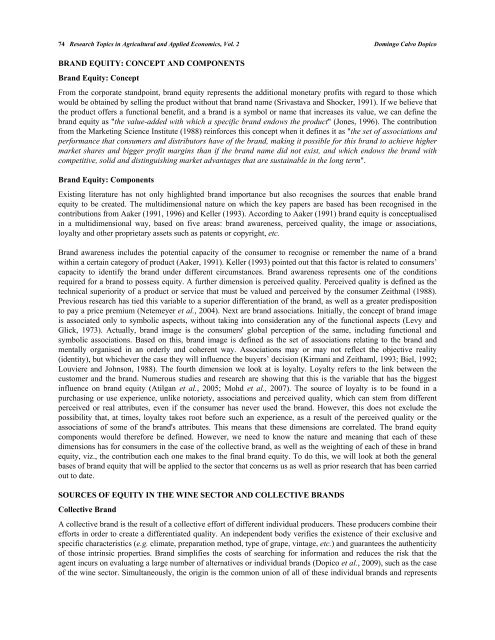chapter 2 - Bentham Science
chapter 2 - Bentham Science
chapter 2 - Bentham Science
Create successful ePaper yourself
Turn your PDF publications into a flip-book with our unique Google optimized e-Paper software.
74 Research Topics in Agricultural and Applied Economics, Vol. 2 Domingo Calvo Dopico<br />
BRAND EQUITY: CONCEPT AND COMPONENTS<br />
Brand Equity: Concept<br />
From the corporate standpoint, brand equity represents the additional monetary profits with regard to those which<br />
would be obtained by selling the product without that brand name (Srivastava and Shocker, 1991). If we believe that<br />
the product offers a functional benefit, and a brand is a symbol or name that increases its value, we can define the<br />
brand equity as "the value-added with which a specific brand endows the product" (Jones, 1996). The contribution<br />
from the Marketing <strong>Science</strong> Institute (1988) reinforces this concept when it defines it as "the set of associations and<br />
performance that consumers and distributors have of the brand, making it possible for this brand to achieve higher<br />
market shares and bigger profit margins than if the brand name did not exist, and which endows the brand with<br />
competitive, solid and distinguishing market advantages that are sustainable in the long term".<br />
Brand Equity: Components<br />
Existing literature has not only highlighted brand importance but also recognises the sources that enable brand<br />
equity to be created. The multidimensional nature on which the key papers are based has been recognised in the<br />
contributions from Aaker (1991, 1996) and Keller (1993). According to Aaker (1991) brand equity is conceptualised<br />
in a multidimensional way, based on five areas: brand awareness, perceived quality, the image or associations,<br />
loyalty and other proprietary assets such as patents or copyright, etc.<br />
Brand awareness includes the potential capacity of the consumer to recognise or remember the name of a brand<br />
within a certain category of product (Aaker, 1991). Keller (1993) pointed out that this factor is related to consumers’<br />
capacity to identify the brand under different circumstances. Brand awareness represents one of the conditions<br />
required for a brand to possess equity. A further dimension is perceived quality. Perceived quality is defined as the<br />
technical superiority of a product or service that must be valued and perceived by the consumer Zeithmal (1988).<br />
Previous research has tied this variable to a superior differentiation of the brand, as well as a greater predisposition<br />
to pay a price premium (Netemeyer et al., 2004). Next are brand associations. Initially, the concept of brand image<br />
is associated only to symbolic aspects, without taking into consideration any of the functional aspects (Levy and<br />
Glick, 1973). Actually, brand image is the consumers' global perception of the same, including functional and<br />
symbolic associations. Based on this, brand image is defined as the set of associations relating to the brand and<br />
mentally organised in an orderly and coherent way. Associations may or may not reflect the objective reality<br />
(identity), but whichever the case they will influence the buyers’ decision (Kirmani and Zeithaml, 1993; Biel, 1992;<br />
Louviere and Johnson, 1988). The fourth dimension we look at is loyalty. Loyalty refers to the link between the<br />
customer and the brand. Numerous studies and research are showing that this is the variable that has the biggest<br />
influence on brand equity (Atilgan et al., 2005; Mohd et al., 2007). The source of loyalty is to be found in a<br />
purchasing or use experience, unlike notoriety, associations and perceived quality, which can stem from different<br />
perceived or real attributes, even if the consumer has never used the brand. However, this does not exclude the<br />
possibility that, at times, loyalty takes root before such an experience, as a result of the perceived quality or the<br />
associations of some of the brand's attributes. This means that these dimensions are correlated. The brand equity<br />
components would therefore be defined. However, we need to know the nature and meaning that each of these<br />
dimensions has for consumers in the case of the collective brand, as well as the weighting of each of these in brand<br />
equity, viz., the contribution each one makes to the final brand equity. To do this, we will look at both the general<br />
bases of brand equity that will be applied to the sector that concerns us as well as prior research that has been carried<br />
out to date.<br />
SOURCES OF EQUITY IN THE WINE SECTOR AND COLLECTIVE BRANDS<br />
Collective Brand<br />
A collective brand is the result of a collective effort of different individual producers. These producers combine their<br />
efforts in order to create a differentiated quality. An independent body verifies the existence of their exclusive and<br />
specific characteristics (e.g. climate, preparation method, type of grape, vintage, etc.) and guarantees the authenticity<br />
of those intrinsic properties. Brand simplifies the costs of searching for information and reduces the risk that the<br />
agent incurs on evaluating a large number of alternatives or individual brands (Dopico et al., 2009), such as the case<br />
of the wine sector. Simultaneously, the origin is the common union of all of these individual brands and represents

















